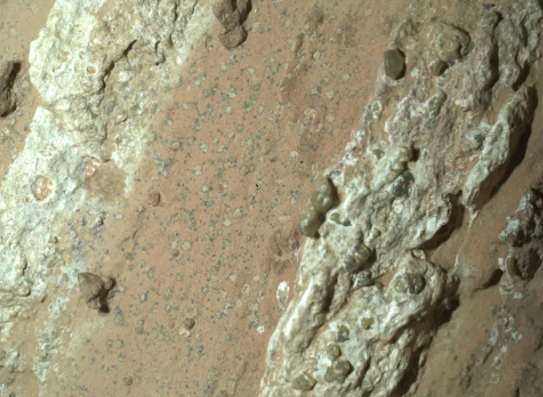
Exobiology is the study of living things beyond Earth. A recent finding by the NASA Martian rover, Perseverance, has created quite a stir at the Agency and in the scientific community.
The rock possibly contains indications of ancient life based on the analysis done by Perseverance’s instrumentation. The chemical signatures obtained and the physical structures within it indicate it formed on the planet during a period when there was abundant water.
Core sampling was done on July 21, 2024. Perseverance was exploring an ancient riverbed at the Jezzero Crater site. The rock was subjected to multiple scans using Perseverance’s onboard instrumentation package known as SHERLOC (Scanning Habitable Environments with Raman & Luminescence for Organics & Chemicals). It detected organic compounds which could indicate life or some non-biological process.
Caltech scientist, Ken Farley, called the find “the most puzzling, complex, and potentially important rock yet investigated by Perseverance.”
What are the processes here on Earth that would produce organic compounds? Photosynthesis is one. But in the absence of light and without photosynthesis even here on Earth, extremophiles exist capable of synthesizing organic compounds and reproducing. If we use prebiotic Earth, however, as a model for understanding the Martian past, could we determine abiotic and biological explanations for what is being observed in this recently discovered rock?
Named Cheyava Falls, it is a 1×0.6 metres (3.2×2 feet), arrow-shaped rock that features lighter striped sediments separated by darker red ones. The latter also shows colourful white splotches surrounded by black halos. There is evidence in the striations that water once passed through it which makes sense since it was found in what was once a riverbed forming part of a much larger complex water feature in the Jezero Crater. The rock is likely 4 billion years old. At that time, Earth and Mars shared some commonalities in terms of chemistry and physical conditions.
On Earth, scientists refer to that period as the planet’s prebiotic phase. The atmosphere was very different in the absence of photosynthesis. Inorganic molecules were present including hydrogen isotopes, ammonia, methane, hydrogen sulphide, and carbon dioxide. There was lots of water on the surface and in the atmosphere as vapour. The Earth had no ozone layer to block ionizing radiation. It was geologically active with lots of outgassing volcanoes. Mars was likely similar.
Scientists have conducted experiments to replicate those early conditions mixing the inorganic compounds of prebiotic Earth with water in laboratory flasks and exposing the contents to ionizing radiation, heat and more. In doing this they have turned a primordial soup into a beaker of organic molecules through a process called reductive synthesis.
On Earth, organic molecules preceded life. They interacted with inorganic molecules in the Earth’s ocean to become chemoautotrophs and photoautotrophs, more complex molecules that used chemistry and sunlight to split water into hydrogen and free oxygen. The photoautotrophs absorbed carbon dioxide using inorganic hydrogen isotopes and reductive synthesis. In time the chemistry of photosynthesis emerged and with it the great oxygenation event that led to the life we see on the planet today.
On Mars, why the Cheyava Falls rock is seen as a significant find isn’t just about the chemistry that SHERLOC discovered. The rock’s appearance is intriguing. Veins of calcium sulphate are separated by hematite. Hematite gives Mars its reddish colour and in this rock it contains irregularly-shaped white spots that are ringed by black halos which have been analyzed as being composed of iron and phosphate. On Earth, features found in old sedimentary rocks like this are associated with fossilized subsurface microbes.
Does this mean there was microbial life on Mars nearly 4 billion years ago? Could there be a prebiotic explanation that fits with what is being observed? The presence of olivine crystals in the rock may provide an abiotic answer. Olivine forms in magma and maybe the white-ringed spots aren’t fossil microbes but the remains of intrusive magma that penetrated the sedimentary rock after it hardened from the mud that first formed it.
SHERLOC has analyzed the Cheyava Falls sample and Perseverance’s other onboard technology has zapped and x-rayed it. Having done all that we still don’t know whether what we are observing are ancient Martian microbes or an abiotic phenomenon. The answer will only come if we can bring back a Cheyava Falls sample or send a future human crew to visit the rock at the Jezero Crater site. Farley states that Perseverance has told us all it can and “has nothing more to give.”
The search for evidence of past and present life on Mars continues. From the first Viking lander experiments that tantalized and teased us, to Perseverance’s latest discovery, we still don’t know whether we the living here on Earth are alone or not in The Universe.
Postscript
I am providing a link to an article that adds more context to the Cheyava Falls discovery. Written by Sarmila Kuthunur and published on the website space.com, it includes an interview with Amy Williams, an astrobiologist at the University of Florida and a member of the Perseverance science team. Williams calls the rock “the most compelling organics signal detection the rover has made so far.”








